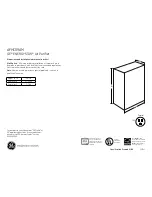
READ ALL SAFETY INFORMATION BEFORE USING
1)
All wiring must comply with local and national
electrical codes and must be installed by a qualified
electrician. If you have any questions regarding the
following instructions, contact a qualified electrician.
2)
Check available power supply and resolve any
wiring problems BEFORE installing and operating
this unit.
3)
This 115V air conditioner uses 10.0 or less
nameplate amps and may be used in any properly
wired, general purpose household receptacle. See
Table 1 for specifications for individual branch
circuit.
4)
For your safety and protection, this unit is
grounded through the power cord plug when plugged
into a matching wall outlet. If you are not sure
whether your wall outlet is properly grounded, please
consult a qualified electrician.
5)
The wall outlet must match the 3-prong plug on
the service cord supplied with the unit. DO NOT use
plug adapters. See Table 2 for receptacle and fuse
information. If it is necessary to use an extension
cord to connect your air conditioner,
use an
approved “air conditioner” extension cord only
(available at most local hardware stores).
6)
The rating plate on the unit contains electrical and
other technical data. The rating plate is located on the
right side of the unit, above the power cord.
TABLE 1
Suggested Individual Branch Circuit
Nameplate Amps
*AWG Wire Size
5.0 to 10
18
AWG- American Wire Gauge
*Based on copper wire at 60°C temperature rating.
TABLE 2
Receptacle and Fuse Types
Rated Volts
120
Amps
10
Wall Outlet
Fuse Size
15
Time Delay Fuse
Plug Type
(or Circuit Breaker)
IMPORTANT SAFETY INFORMATION
ELECTRICAL
SPECIFICATIONS
2
Your Danby appliance is designed to be highly efficient in energy savings. Follow these
recommendations for greater efficiency.
1)
Select a thermostat setting that suits your comfort
needs and leave at that chosen setting.
2)
The filter is very efficient in removing airborne
particles. Keep the air filter clean. Normally, filters
should be cleaned every 2 weeks. More frequent
cleaning may be necessary depending on indoor air
quality.
3)
Use drapes, curtains or shades to keep direct
sunlight from penetrating and heating room, but do
not allow drapes or curtains to obstruct the air flow
around the unit.
4)
Start your air conditioner before the outdoor air
becomes hot and uncomfortable, to avoid an initial
period of discomfort while the unit is cooling off
the room.
5)
When outdoor temperatures are cool enough, use
HIGH or LOW FAN only. This circulates indoor
air, providing some cooling comfort, and utilizes
less electricity than when operating on a cooling
setting.
ENERGY-
SAVING TIPS


































